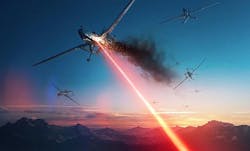Air Force reaching out to industry for latest in high-power fiber lasers for airborne laser weapons
KIRTLAND AIR FORCE BASE, N.M. – U.S. Air Force airborne weapons experts are surveying industry for beam-combining high-powerfiber lasers and amplifiers suitable for aircraft laser weapons. The Air Force is interested in multiple beam-combining architectures including tiled and filled array for laser weapon systems.
Officials of the Air Force Research Laboratory's Directed Energy Directorate at Kirtland Air Force Base, N.M., issued a source-sought notice on Tuesday (RFI-AFRL-RVKDL-2017-0005) for the High Energy Combinable Fiber Laser Advanced Research Effort (FLARE) project.
Air Force researchers want to know about industry's ability to mature robust narrow line width fiber lasers suitable for future combat aircraft that have challenging size, weight, and power (SWaP) considerations.
Of particular interest are coherent or spectral beam combining architectures. The FLARE project is part of the Air Force Research Lab Fiber Laser and Beam Combining (FLBC) program.
Air Force researchers also are interested in similar technologies for ground-to-air anti-aircraft applications using comparable combining architectures.
From industry, the Air Force wants information on past and current experience in high-power fiber lasers, including the highest power in continuous or pulsed fiber lasers achieved; high-energy programs supported; and expertise in the component, subsystem, and systems-integration level.
Researchers also want to know about industry's ability to reduce the size and weight of high-brightness, low-SWaP laser diodes for pumping fiber amplifier systems, while increasing output power, electrical-to-optical efficiency, and optimizing module design for dense packaging.
Related: At long last, laser weapons are nearing deployment
The Air Force also wants to know about industry's ability to create computer models predict the performance of fiber coupled laser diode cooling; optical pumping of fibers; optical fiber designs including active and passive conventional, microstructure large-mode area (LMA) fibers; high-power scaling of rare-earth doped optical fiber amplifiers (including Erbium, Ytterbium and Thulium fibers); mitigation of deleterious non-linear optical and thermo-optics effects in fibers; and beam combining multiple high power fiber sources.
The Air Force Research Lab wants unclassified white papers no longer than 10 pages by 12 Oct. 2017. Companies interested should submit white paper hard copies and on CD ROM by post to AFRL Det 8/RVKDL, Attn: Christopher Lockridge, Contract Specialist, 3550 Aberdeen Ave. SE, Kirtland AFB, NM 87117-5776.
More information is online at https://www.fbo.gov/spg/USAF/AFMC/AFRLPLDED/RFI-AFRL-RVKDL-2017-0005/listing.html.
Learn more: search the Aerospace & Defense Buyer's Guide for companies, new products, press releases, and videos

